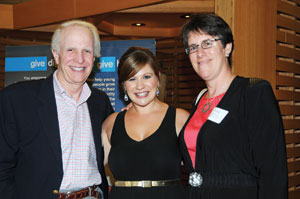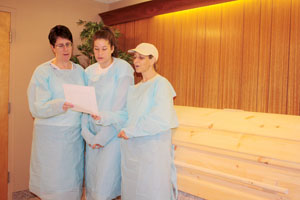 Three gowned and gloved women speak quietly with a man. “Any issues,” one asks.” He responds that there are stents and stitches from a recent surgery, a few clear bandages that will need to be removed. “But no problems,” he adds. “This should go quickly.”
Three gowned and gloved women speak quietly with a man. “Any issues,” one asks.” He responds that there are stents and stitches from a recent surgery, a few clear bandages that will need to be removed. “But no problems,” he adds. “This should go quickly.”
“This” is a Tahara, the Jewish ritual process of preparing bodies for burial. The gowned and gloved women are members of the women’s committee of the Chevra Kadisha (there is a men’s group as well). And the man from whom they’re receiving last-minute instructions could be Marc Williams, Neil Shanberg or Jim Taylor, funeral directors at Louis Memorial Chapel, owned by the Henry Epstein family.
There is no repayment for Tahara — the final mitzvah given to a deceased Jew. It is performed by the members of the Chevra Kadisha, translated as “Holy Society,” who do so for a variety of reasons. The task begins and ends with prayer, asking that those present do the work with humility and modesty, and then, after closing the casket, asking for forgiveness for any offense and wishing the family of the deceased “comfort among the mourners of Zion.”
Playing a vital role
The Kansas City Jewish community is aging and this spring the Chevra Kadisha was busier than ever performing Taharas. The members of the Chevra are all volunteers, led by Dr. Rosa Solomon. Rabbi Daniel Rockoff, spiritual leader of Kansas City’s Orthodox synagogue Congregation Beth Israel Abraham & Voliner, is its rabbinic leader.
 “Throughout history, groups within every community have accepted this holy task with honor and a sense of modesty, if not outright secrecy. Members of the Chevra never call attention to themselves, nor do they discuss any particulars of a Tahara process they have performed,” says Rabbi Rockoff.
“Throughout history, groups within every community have accepted this holy task with honor and a sense of modesty, if not outright secrecy. Members of the Chevra never call attention to themselves, nor do they discuss any particulars of a Tahara process they have performed,” says Rabbi Rockoff.
“One of the most beautiful aspects is that other than the prayers recited, the whole ritual is performed in near silence. It follows the Jewish tradition of providing the dead with proper kavod acharon, final honor and respect.”
New recruits are always needed to replace those who are no longer able to continue to serve. It usually takes less than an hour to perform a Tahara, but volunteers need to be flexible because it’s impossible to plan in advance.
“Almost all Taharas are done in the mornings, which can be challenging particularly for the men,” explained Diana Newman, who serves as chairman of the calling committee. “We do have a few volunteers with more flexibility than others, but I wish there were more. Pulling a team together can at times take hours … I would love to see the volunteer list increase in number; people with flexible schedules would be very welcomed,” she adds.
Any Jewish person in Kansas City is welcome to join the Chevra. A recruitment meeting is planned for the near future. The origin, meaning and rationale of the Hebrew prayers recited during a Tahara will be explained and discussed.
The Chevra includes volunteers from a variety of congregations here in Greater Kansas City. As longtime volunteer Mindy Wajcman points out, volunteers need not be religious, nor do they need to know Hebrew, to participate. Dr. Solomon, who is a member of BIAV and worships at Torah Learning Center, is more than happy to answer questions from potential volunteers.
Rabbi Rockoff notes that the Chevra Kadisha certainly doesn’t want to call attention to itself, but it is vital that the community understand the important work it does.
“We need to be able to educate people about the importance and beauty of this ritual, and we also are always looking for new recruits to join this special group,” he said.
Why join the Chevra?
Dr. Solomon joined the Chevra in the mid-1970s while she was still in dental school. She was mentored by Naomi Berger, who was the rebbetzin of BIAV, and Chana Weinstock, the group’s volunteer leader.
“They instilled in me the special quality of this work, which is referred to a chesed shel emet, a true kindness, pure and simple. This continues to motivate me to this day.”
Craig Kaplan, a member of Kehilath Israel Synagogue, has been a member of the Chevra Kadisha for more than 18 years.
“I view this as an honor, by doing something for someone and not expecting anything in return. There is an inner peace one experiences when preparing someone for burial properly and according to halachah (Jewish law),” Kaplan explained. “It provides the person being buried with dignity, the family with the knowledge that their loved one was properly prepared according to Jewish rules and tradition and the person doing the Tahara with comfort in being honored to be able to provide these things. It is one of the best ways one can give back to the Jewish community.”
Newman was asked to be part of the Chevra Kadisha about 25 years ago.
“I was hesitant to accept at first because I am one of those people with weak stomachs and wasn’t sure how I would react. What if I had to step out or couldn’t handle it?” she said.
A person considering joining the Chevra always goes to a Tahara as a fourth member to observe because of this possibility.
“However, when I went the first time, I was part of a group of three and actively participated in the Tahara. I have to say it was one of the most moving experiences of my life,” said Newman, a member of BIAV.
“I feel a responsibility to the other women I am with and, most importantly, the women whose body and soul we are attending,” added Elisa Pener, a veteran member of the Chevra. “In addition, I feel an incredible presence around me as I perform this task.” Pener, a registered nurse who works at both Hyman Brand Hebrew Academy during the school year and Camp Ramah in Wisconsin during the summer, is a longtime member of Congregation Beth Shalom.
Joseph Megerman grew up watching his parents Drs. Charles and Esther Megerman perform many mitzvot, including serving the Chevra Kadisha. Just 35, Megerman joined the group nearly eight years ago.
“Besides being a tremendous mitzvah, it really gives you perspective,” he said. “Young people aren’t always certain how they fit in to the larger community or how they can help. The Chevra is among the purest forms of k’lal Yisrael. It is the best combination of being a people and a religion.”
“Young people have energy, strength and enthusiasm. All are an asset in this endeavor,” he added.
Shira Newman, 25, is one of the Chevra’s youngest members and got involved through her mother Diana.
“I believe that many young people have a misconception about what we do. In actuality, it is one of the most beautiful acts that is performed in Judaism,” Shira Newman said. “As a member, you are able to do the highest mitzvah possible, because you are being completely selfless.”
The Tahara process
Rochel U. Berman’s book, “Dignity Beyond Death” explains the origin of Tahara, as well as instructions in how to perform the ritual.
“It is traditionally believed that G-d performed the work of the Chevra Kadisha for Moses,” Berman writes. “In Ecclesiastes we read, ‘As he came, so shall he go.’ Just as newborns are washed and dressed as they enter this world, so are the deceased cleansed, purified and dressed as they depart.”
The remaining steps of the process include cleaning, ritual washing, dressing and placing the deceased in the casket. Anything needed for the Tahara — whether it’s a cotton ball or a small cup of water — is handed around the body, never over it. The right side is washed first, then the left. The volunteers leave the room, ritually wash their hands again, empty the bucket used for washing and refill it along with two more for the actual Tahara — the purification part of the ritual. Boards washed in the clean water are placed beneath the deceased. Since the mikvah cannot be used, the water is poured in a continuous stream to reach every part of the body, with each woman reciting “Tahara-he” three times. After re-covering the deceased with a clean sheet, the volunteers dry and dress the deceased in natural fiber shrouds.
Called tachrichim, these shrouds consist of drawstring pants, two long-sleeved shirts (the top one has lace down the front for women), a bonnet (for women) and head covering. Long ribbons of the same material are tied around each leg and around the torso. The ribbons are tied with slipknots, as are the pants and shirts. And the long ribbon around the torso is tied with three loops, signifying the Hebrew letter Shin. Those dressing the deceased recite “aleph, bet, gimel, daled,” before tying each slipknot, notes a member of the Chevra Kadisha. “The body represents the Hebrew letter yud,” Berman adds. “When you add the shin, you have one of G-d’s names.”
After being placed in a casket, soil from Eretz Yisrael — a lasting connection to the Holy Land — is sprinkled over the heart, genitals, eyes and mouth (the last two also covered by broken shards of pottery as a symbol of the frailty of human life). The linen sheet is wrapped around the body; the lid is placed on the casket and it’s wheeled from the preparation room to a holding room. After final prayers, and a request for forgiveness from the members of the Chevra, the funeral and burial can proceed.
Men follow the same steps with several small differences, says a 29-year veteran of the men’s group who prefers to remain anonymous.
“While women tie the bindings under the knees to represent a skirt, men tie them at the ankles. And a man’s outer garment has embroidery instead of the lace that the women have,” he notes. He also describes the “choreography of the Tahara” as a “silent dance, taken on by three men without talking. Yet there’s a fourth man in the room, so it’s truly magical.”
He also notes that men are buried with their tallis. “We cut one set of fringes,” he adds, “making the tallis unkosher since it’s no longer being used. Occasionally, if I know the family of the deceased, I’ll give them the fringes.”
The final act is to wash hands outside of the funeral home, without a blessing and without drying the hands.
“The water represents the tears of Israel,” writes Berman.
For more information about the Chevra Kadisha, contact Dr. Solomon at .
Carol Katzman has been a member of the Chevra Kadisha for 17 years, two-and-a-half years here in Kansas City.
 Last week Missouri voters approved a state constitutional amendment known as the “right to pray” amendment. Supporters, according to the Kansas City Star, claim the amendment will protect religious freedom. Those opposed believe the amendment is unconstitutional and are already challenging it in court.
Last week Missouri voters approved a state constitutional amendment known as the “right to pray” amendment. Supporters, according to the Kansas City Star, claim the amendment will protect religious freedom. Those opposed believe the amendment is unconstitutional and are already challenging it in court.


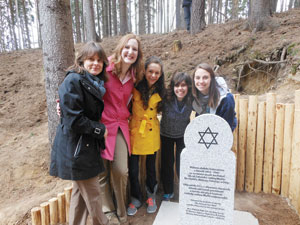 Teachers in the Kansas City area, many who began the school year this week, are looking for new ways to make an impact on students with Holocaust education. Several have gone on trips to Europe to glean new information and multimedia tools for their classrooms.
Teachers in the Kansas City area, many who began the school year this week, are looking for new ways to make an impact on students with Holocaust education. Several have gone on trips to Europe to glean new information and multimedia tools for their classrooms. When Congregation Kol Ami decided in July to leave its building of seven years, its evolution as a spiritual community entered a new phase.
When Congregation Kol Ami decided in July to leave its building of seven years, its evolution as a spiritual community entered a new phase. SPECIAL WELCOME — Kansas Citians Alana Gaffen and Mai Bonomo are making aliyah and were on a special flight of 350 North American olim (new immigrants) that landed in Israel Tuesday. Immediately after becoming an Israeli citizen, Alana and Mai will be joining the Israel Defense Forces as part of a record high 127 soon-to-be IDF soldiers. The special Friends of the Israel Defense Forces–Nefesh B’Nefesh flight was organized in cooperation with the Ministry of Immigrant Absorption, the Jewish Agency for Israel, Keren Kayemeth Le’Israel and Tzofim Garin Tzabar.
SPECIAL WELCOME — Kansas Citians Alana Gaffen and Mai Bonomo are making aliyah and were on a special flight of 350 North American olim (new immigrants) that landed in Israel Tuesday. Immediately after becoming an Israeli citizen, Alana and Mai will be joining the Israel Defense Forces as part of a record high 127 soon-to-be IDF soldiers. The special Friends of the Israel Defense Forces–Nefesh B’Nefesh flight was organized in cooperation with the Ministry of Immigrant Absorption, the Jewish Agency for Israel, Keren Kayemeth Le’Israel and Tzofim Garin Tzabar.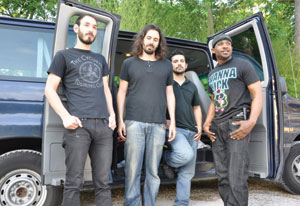 JAZZ-ROCK CONCERTS — Jazz-rock band Marbin will be in town soon for two different performances. The first show is at 8 p.m. Thursday, Aug. 16, at the Buzz Pub & Perk in Overland Park. The second is at 5 p.m. Sunday, Aug. 19, at the Longbranch Saloon in Lenexa. Marbin boasts a unique blend of rock, jazz and blues — even a hint of bittersweet, melodic Eastern European folk that draws on guitarist Dani Rabin and saxophonist Danny Markovitch’s Israeli origins. Marbin, an all-original and all-instrumental band, is touring across the country for most of the year. Marbin has played with or recorded with many well-known, well-respected musicians including multiple Grammy Award-winners Paul Wertico and Steve Rodby (both members of the Pat Metheny Group), Allan Holdsworth, Mike Clark (Headhunters), Jamey Haddad (Paul Simon), Jeff Berlin (Yes), Scott Henderson (Tribal Tech), Jimmy Haslip (Yellowjackets) and Virgil Donati (Planet X).
JAZZ-ROCK CONCERTS — Jazz-rock band Marbin will be in town soon for two different performances. The first show is at 8 p.m. Thursday, Aug. 16, at the Buzz Pub & Perk in Overland Park. The second is at 5 p.m. Sunday, Aug. 19, at the Longbranch Saloon in Lenexa. Marbin boasts a unique blend of rock, jazz and blues — even a hint of bittersweet, melodic Eastern European folk that draws on guitarist Dani Rabin and saxophonist Danny Markovitch’s Israeli origins. Marbin, an all-original and all-instrumental band, is touring across the country for most of the year. Marbin has played with or recorded with many well-known, well-respected musicians including multiple Grammy Award-winners Paul Wertico and Steve Rodby (both members of the Pat Metheny Group), Allan Holdsworth, Mike Clark (Headhunters), Jamey Haddad (Paul Simon), Jeff Berlin (Yes), Scott Henderson (Tribal Tech), Jimmy Haslip (Yellowjackets) and Virgil Donati (Planet X). Three gowned and gloved women speak quietly with a man. “Any issues,” one asks.” He responds that there are stents and stitches from a recent surgery, a few clear bandages that will need to be removed. “But no problems,” he adds. “This should go quickly.”
Three gowned and gloved women speak quietly with a man. “Any issues,” one asks.” He responds that there are stents and stitches from a recent surgery, a few clear bandages that will need to be removed. “But no problems,” he adds. “This should go quickly.” “Throughout history, groups within every community have accepted this holy task with honor and a sense of modesty, if not outright secrecy. Members of the Chevra never call attention to themselves, nor do they discuss any particulars of a Tahara process they have performed,” says Rabbi Rockoff.
“Throughout history, groups within every community have accepted this holy task with honor and a sense of modesty, if not outright secrecy. Members of the Chevra never call attention to themselves, nor do they discuss any particulars of a Tahara process they have performed,” says Rabbi Rockoff.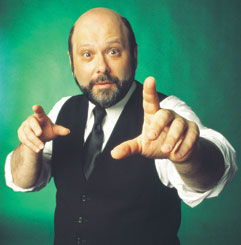 When the Kollel honors Ward Katz on Tuesday, Aug. 21, be prepared to be amazed. Yes you will be amazed at all the great things Katz has done for the community. But the entertainer is expected to blow your mind, or at least read it.
When the Kollel honors Ward Katz on Tuesday, Aug. 21, be prepared to be amazed. Yes you will be amazed at all the great things Katz has done for the community. But the entertainer is expected to blow your mind, or at least read it. Old family photos adorn each wall of Marv’s Delicatessen, but the décor isn’t what makes the restaurant in Leawood’s Park Place unique. This delicatessen’s specialty is kosher-style food.
Old family photos adorn each wall of Marv’s Delicatessen, but the décor isn’t what makes the restaurant in Leawood’s Park Place unique. This delicatessen’s specialty is kosher-style food. He picked the Park Place development at 115th Street and Nall Avenue because “it’s in the sweet spot for the Jewish community but also has heavy lunch traffic. It’s the epicenter of the Jewish Community Center, two big temples and Village Shalom.”
He picked the Park Place development at 115th Street and Nall Avenue because “it’s in the sweet spot for the Jewish community but also has heavy lunch traffic. It’s the epicenter of the Jewish Community Center, two big temples and Village Shalom.”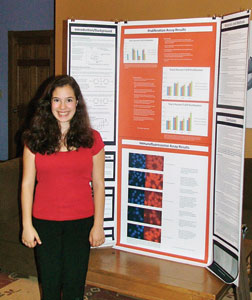 Most high school students read about science research in text books. Recent high school graduate Sarina Farb, 18, has already conducted her own research.
Most high school students read about science research in text books. Recent high school graduate Sarina Farb, 18, has already conducted her own research.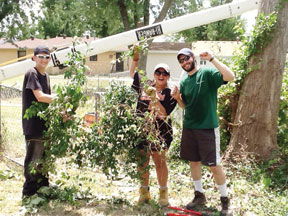 For six weeks ending Monday, Aug. 6, 12 teens and their four adult leaders slept in a classroom at Congregation Ohev Sholom, showered and enjoying the facilities of the Jewish Community Center, and most importantly, volunteered in the greater Kansas City area and Joplin.
For six weeks ending Monday, Aug. 6, 12 teens and their four adult leaders slept in a classroom at Congregation Ohev Sholom, showered and enjoying the facilities of the Jewish Community Center, and most importantly, volunteered in the greater Kansas City area and Joplin.